Introduction
Stir-fried celery, a staple in Asian cuisine, is a dish that marries simplicity with explosive flavor. Often overlooked in Western cooking, celery’s crisp texture and mild, grassy notes transform when subjected to high heat and aromatic seasonings. This guide delves into the nuances of crafting the perfect stir-fried celery, a dish that requires precision, timing, and an understanding of balance. Whether you’re a novice cook or a seasoned home chef, mastering this recipe will equip you with a versatile skill applicable to countless Asian-inspired meals. Beyond its culinary appeal, stir-fried celery boasts nutritional benefits—low in calories, high in fiber, and rich in vitamins K and C. This article will explore the origins of the dish, its cultural significance, and the scientific principles that elevate it from mundane to magnificent.
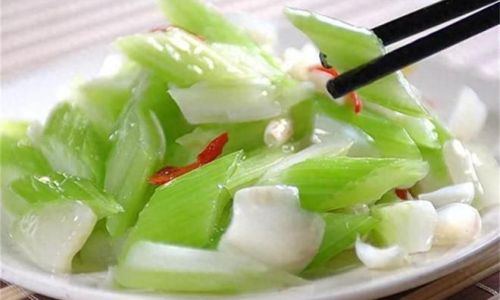
The Humble Beginnings of Stir-Fried Celery
Celery, or Apium graveolens, has been cultivated for millennia, with records tracing back to ancient Mediterranean and Chinese civilizations. In China, celery—known as qincai—was initially valued for its medicinal properties before transitioning to culinary use. Stir-frying, a technique perfected during the Song Dynasty (960–1279 CE), became the ideal method to preserve the vegetable’s crunch while infusing it with complex flavors. Today, stir-fried celery appears on menus across Asia, adapted to regional preferences. In Sichuan cuisine, it’s often paired with chili and Sichuan peppercorns, while Cantonese versions emphasize freshness with minimal seasoning. Understanding this history enriches the cooking process, transforming a simple vegetable into a cultural ambassador.
Ingredients: The Foundation of Flavor
The beauty of stir-fried celery lies in its minimalist ingredient list, which amplifies the vegetable’s inherent qualities. Here’s a breakdown of essential components:
- Celery (400g): Opt for fresh, crisp stalks with vibrant green leaves. Avoid limp or yellowing specimens. Chinese celery, thinner and more aromatic than its Western counterpart, is traditional but not mandatory.
- Aromatics:
- Garlic (3 cloves, minced): Adds pungency and depth.
- Ginger (1-inch piece, julienned): Imparts a subtle warmth.
- Scallions (2 stalks, sliced): Contribute mild onion notes.
- Seasonings:
- Light soy sauce (1 tbsp): For saltiness and umami.
- Oyster sauce (1 tsp, optional): Enhances richness (vegan alternatives available).
- Sesame oil (½ tsp): Provides a nutty finish.
- White pepper (¼ tsp): Adds a hint of spice.
- Cooking Oil (2 tbsp): Use peanut, vegetable, or avocado oil for high-heat tolerance.
- Add-Ins (Optional):
- Dried chili flakes: For heat.
- Shaoxing wine: Deglazes the pan and adds complexity.
- Cornstarch slurry: Thickens the sauce (if desired).
Preparation: The Devil Is in the Details
Celery Prep:
- Trimming: Remove the base and leaves (reserve leaves for garnish if desired).
- Washing: Rinse under cold water, scrubbing gently to remove dirt.
- Cutting: Slice stalks diagonally into 2-inch pieces. Diagonal cuts maximize surface area, ensuring even cooking and better sauce absorption.
Aromatic Prep:
- Mince garlic and ginger finely to ensure they meld seamlessly into the dish.
- Slice scallions into 1-inch segments, separating white and green parts for staggered cooking.
Mise en Place:
- Arrange ingredients near the stove. Stir-frying is a rapid process; delays result in overcooked celery.
The Science of Stir-Frying: Heat and Timing
Stir-frying is a high-heat, quick-cooking method that relies on the Maillard reaction and caramelization to develop flavor. A carbon-steel wok is ideal, as it distributes heat efficiently and retains high temperatures. However, a large skillet works in a pinch.

Heating the Wok:
- Place the wok over high heat for 2–3 minutes until drops of water evaporate instantly.
- Add oil and swirl to coat the surface. Proper heating prevents sticking and ensures a searing effect.
Cooking the Aromatics:
- Add garlic, ginger, and white scallion parts. Stir-fry for 10–15 seconds until fragrant but not browned. Overcooking aromatics introduces bitterness.
Introducing the Celery:
- Toss in the celery and stir-fry vigorously. The high heat sears the edges, locking in moisture and crispness.
- Maintain constant motion to prevent burning. A spatula and wok ladle combination facilitates efficient tossing.
Seasoning Timing:
- Add soy sauce and oyster sauce (if using) midway through cooking. These liquid seasonings deglaze the pan, incorporating flavorful browned bits.
- Avoid adding salt early, as it draws moisture from the celery, leading to sogginess.
Finishing Touches:
- Drizzle sesame oil and sprinkle white pepper in the final moments.
- Toss in scallion greens and reserved celery leaves for a pop of color.
Achieving Perfect Texture: Crisp-Tender Mastery
The goal is tender celery with a slight resistance—a texture known as al dente in Italian cuisine. Overcooking yields mushy, olive-green stalks, while undercooking results in fibrous, raw bites.
Troubleshooting Texture Issues:

- Soggy Celery: Reduce heat or cook in smaller batches to prevent steaming.
- Uneven Cooking: Slice celery uniformly. Thicker pieces may require blanching before stir-frying.
- Burnt Aromatics: Lower the heat if the wok smokes excessively. Adjust oil quantity if ingredients stick.
Variations and Customizations
Stir-fried celery’s adaptability makes it a canvas for creativity. Experiment with these twists:
Protein Pairings:
- Pork: Marinate thinly sliced pork belly in soy sauce, Shaoxing wine, and cornstarch before adding to the wok.
- Shrimp: Sauté shelled shrimp until pink, then set aside and incorporate at the end.
- Tofu: Use firm tofu cubes, pan-fried until golden, for a vegetarian protein boost.
Vegetable Additions:
- Mushrooms: Enoki or shiitake mushrooms add earthy depth.
- Bell Peppers: Sliced red or yellow peppers contribute sweetness and color.
- Water Chestnuts: For extra crunch.
Flavor Profiles:
- Spicy: Double the chili flakes or add fresh bird’s-eye chilies.
- Savory-Sweet: Incorporate a teaspoon of hoisin sauce or honey.
- Citrusy: Finish with a squeeze of lime juice and zest.
Serving Suggestions
Stir-fried celery pairs beautifully with:
- Steamed Rice: The classic accompaniment.
- Noodles: Toss with udon or egg noodles for a hearty meal.
- Congee: Elevate the humble rice porridge with a vibrant side.
- Lettuce Wraps: Serve as a filling for crisp lettuce cups.
Common Pitfalls and How to Avoid Them
Overcrowding the Wok:
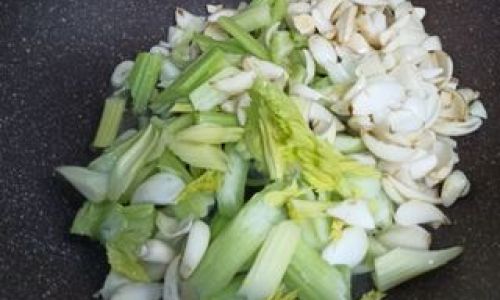
- Issue: Too many ingredients lower the wok’s temperature, causing steaming instead of stir-frying.
- Solution: Cook in batches if necessary. A crowded wok = soggy celery.
Inconsistent Oil Temperature:
- Issue: Cold oil leads to greasy, limp vegetables.
- Solution: Ensure the oil shimmers but doesn’t smoke before adding ingredients.
Neglecting Prep Work:
- Issue: Chopping ingredients mid-cooking results in overcooked celery.
- Solution: Prep everything beforehand—stir-frying is a dance of speed and precision.
Over-Seasoning:
- Issue: Excessive soy sauce or salt drowns the celery’s delicate flavor.
- Solution: Taste and adjust seasonings gradually. Remember, you can always add more, but you can’t remove it.
The Cultural Tapestry of Stir-Fried Celery
In Chinese households, stir-fried celery symbolizes prosperity and hard work—qualities reflected in its crisp, unyielding texture. During Lunar New Year celebrations, it’s often served as a symbol of good fortune. The dish’s simplicity also embodies the philosophy of hao chi bu dan (delicious without fuss), a testament to the idea that the finest flavors emerge from respect for ingredients and technique.
Advanced Techniques: Elevating Your Craft
Wok Hei (The Breath of the Wok):
- Achieved by cooking over intense heat, wok hei imparts a smoky, charred aroma. To master it, ensure your wok is screaming hot and toss ingredients with vigor.
Velveting (for Protein):
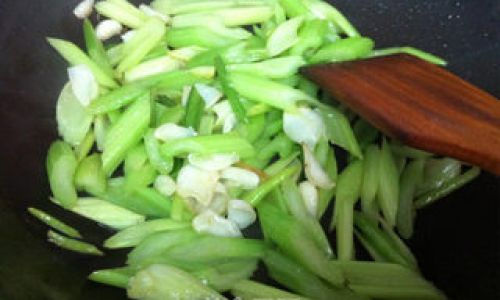
- Marinate meat in a mixture of egg white, cornstarch, and oil to lock in moisture. Blanch in oil or water before stir-frying for silky textures.
Plate Presentation:
- Garnish with toasted sesame seeds or microgreens for a restaurant-quality touch. Arrange celery artfully to highlight its vibrant color.
Conclusion: The Joy of Stir-Frying
Stir-fried celery is more than a recipe—it’s a meditation on balance, heat, and timing. By mastering this dish, you gain insight into the heart of Asian cooking: the ability to transform humble ingredients into something extraordinary. Whether you’re rushing home after work or hosting a dinner party, this recipe offers a reliable canvas for creativity. Experiment, adapt, and most importantly, savor the process. After all, the best dishes are those made with intention, patience, and a love for the craft. So grab your wok, crank up the heat, and let the sizzle begin. Your journey to stir-fry mastery starts here.
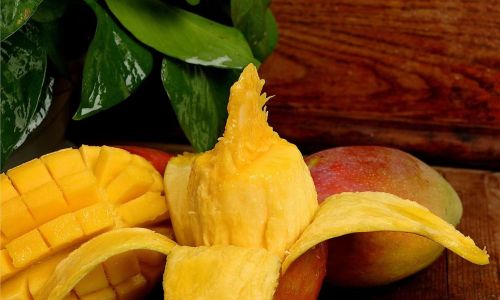
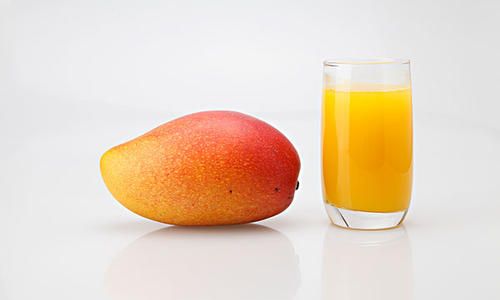




0 comments